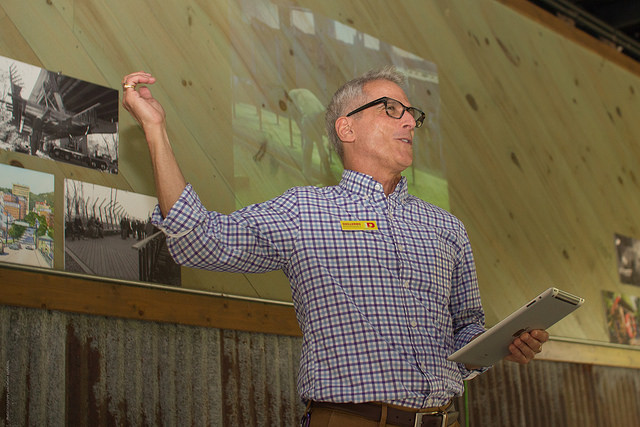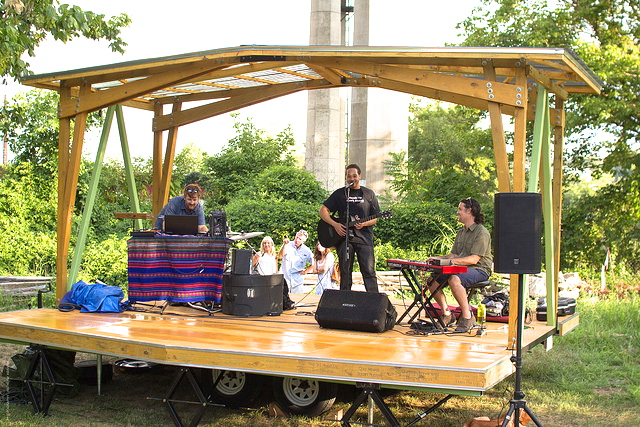When the first-ever LEAF Downtown festival took place on Aug. 1 and 2 in Pack Square Park, it wasn’t just the festival’s new location that was making its debut: This year, the organization was able to unveil its all-new U-LEAF stage — a mobile art stage recently completed by AVL DesignBuild Studio, a summer internship program run by local nonprofit Asheville Design Center.
DesignBuild Studio offers undergraduate design students a summer internship where they can hone their skills in a collaborative project that benefits Asheville and its public spaces.
Last Thursday night, Aug. 6, the Design Center held a donor appreciation event at The Boathouse at 318 Riverside Drive, where DesignBuild Studio interns mingled with ADC donors and board members, while Jonathan Santos and his band played soul and R&B tunes from the brand new stage that had been parked by the river.
LEAF CFO and Head of Production Leigh Maher, explained that the U-LEAF stage promises to be a important aid to LEAF’s growth.
“The idea with the U-LEAF is that we can now create mobile events that can go to community centers, Parks and Rec centers, neighborhoods, and even use in our Schools & Streets program — where LEAF can do these mini-events that can work for those communities independently,” Maher said.
Maher noted that while many people associate LEAF mainly with its spring and fall festivals held at Camp Rockmont, the fact is the organization has several other key programs: LEAF Downtown, LEAF International and the U-LEAF stage all are playing a part in evolving the organization into a full-fledged community arts organization — with its overarching goal of preserving, honoring and celebrating diverse cultures and their art.
Asheville Design Center first gained visibility in 2006 when it developed its own I-26 Connector plan for the N.C. Department of Transportation. In the following years, explains ADC board chairman Guillermo Rodriguez, his organization was approached by several neighborhoods that needed help with “big picture planning.” ADC started to see a huge community demand for good urban design and it was to meet such needs that they first launched DesignBuild Studio in the summer of 2010 with the pilot project Mystic Dreams Pavilion, located at Burton Street Peace Garden.

“We wanted to find a way to actually deliver something more than a report,” says architect Luke Perry, who has co-instructed each summer’s Studio with architect Miriam Gee. “We wanted to produce something that was real and could be used by some of the communities that Asheville Design Center was working with.”
In addition to Mystic Dreams Pavilion and U-LEAF stage, DesignBuild Studio’s projects include The 13 Bones Pedestrian Bridge — part of the Wilma Dykeman Riverway plan (the Studio’s 2012 project) and the YWCA Outdoor Classroom and Laurie Masterson Edible Garden (the Studio’s 2014 project).
In addition to gaining skills, creating a common language across disciplines, and benefiting Asheville’s streets and neighborhoods, DesignBuild Studio gives students a model of design-activism and civic engagement that they can take back to their own communities, explains ADC Executive Director Chris Joyell.
This year’s 10-week Studio session combined the experience and know-how of 13 college students representing six different disciplines, including architecture, landscape architecture, engineering, management and mechatronics.
Chad Ekre, a UNCA/NC State mechatronics student and 2015 intern, said his experience will give his resumé a nice boost, and that it also provided him the opportunity to cultivate meaningful connections and relationships. “Our [mechatronics] program is intensive, but to take all of that theory and put it into practice is a difficult thing to find for a summer project,” he said. “A lot of folks just go do internships where they work on the factory floors or they just do grunt work.”
Though only one of the universities that ADC partners with is currently offering course credit — Clemson — Rodriguez explains that ADC’s goal is to get more of them on board as it grows the program.
Rodriguez explained that ADC is currently trying to build the capacity to enable more public projects, but that in order to do that they need to increase their visibility and build capacity and manpower, which will require funding.

Rodriguez says that design is part of our everyday lives, it’s integral to every aspect of how we relate to our environment, and that it’s ADC’s mission not only to provide good design to neighborhoods and organizations that need it, but to make good design more of a municipal priority on an urban planning level as well.
“I want Asheville to raise the expectations of our community leaders so that we don’t just go through a planning process and get stuck with a building that looks like a hundred other buildings in Charlotte or Atlanta. I want it to look like something that came out of Asheville … We deserve better and we deserve cutting-edge design.”
In a local milieu that often pits historic preservation against development, the ADC sees good design honoring both, and sees Asheville at a crossroads. “Asheville’s at a critical point right now where it really needs good design to identify itself and set itself apart, while still holding onto its identity” says Luly Abraira, partner at Alembic Studio and ADC board member, “Design is very powerful and it’s underestimated a lot when it comes to the city determining what to spend the budget on.”
This fall, Abraira says the ADC will be developing a strategic plan largely around coalescing a stronger relationship with the city. As far as the DesignBuild Studio goes, if you’ve got a public project that you’d like to see come to fruition, this fall the ADC will be accepting applications for next year’s project. For more information and how to get involved, visit AshevilleDesignCenter.org.




correction:
DesignBuild Studio offers undergraduate (and graduate) design students a summer internship where they can hone their skills in a collaborative project that benefits Asheville and its public spaces.
UNC Charlotte students will also receive credit for the studio.